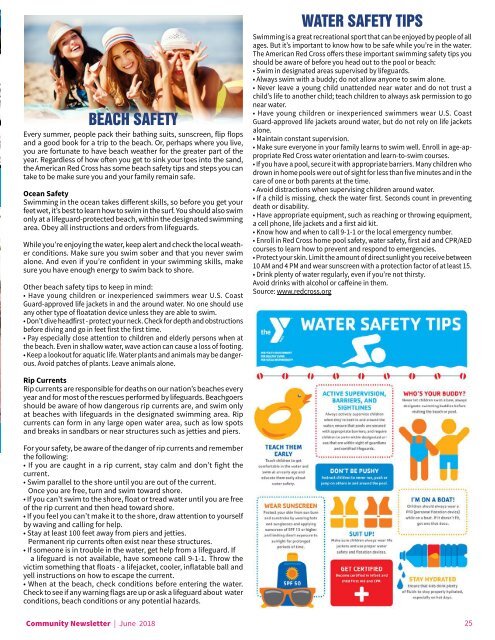Raintree Village June 2018
Create successful ePaper yourself
Turn your PDF publications into a flip-book with our unique Google optimized e-Paper software.
BEACH SAFETY<br />
Every summer, people pack their bathing suits, sunscreen, flip flops<br />
and a good book for a trip to the beach. Or, perhaps where you live,<br />
you are fortunate to have beach weather for the greater part of the<br />
year. Regardless of how often you get to sink your toes into the sand,<br />
the American Red Cross has some beach safety tips and steps you can<br />
take to be make sure you and your family remain safe.<br />
Ocean Safety<br />
Swimming in the ocean takes different skills, so before you get your<br />
feet wet, it’s best to learn how to swim in the surf. You should also swim<br />
only at a lifeguard-protected beach, within the designated swimming<br />
area. Obey all instructions and orders from lifeguards.<br />
While you’re enjoying the water, keep alert and check the local weather<br />
conditions. Make sure you swim sober and that you never swim<br />
alone. And even if you’re confident in your swimming skills, make<br />
sure you have enough energy to swim back to shore.<br />
Other beach safety tips to keep in mind:<br />
• Have young children or inexperienced swimmers wear U.S. Coast<br />
Guard-approved life jackets in and the around water. No one should use<br />
any other type of floatation device unless they are able to swim.<br />
• Don’t dive headfirst - protect your neck. Check for depth and obstructions<br />
before diving and go in feet first the first time.<br />
• Pay especially close attention to children and elderly persons when at<br />
the beach. Even in shallow water, wave action can cause a loss of footing.<br />
• Keep a lookout for aquatic life. Water plants and animals may be dangerous.<br />
Avoid patches of plants. Leave animals alone.<br />
WATER SAFETY TIPS<br />
Swimming is a great recreational sport that can be enjoyed by people of all<br />
ages. But it’s important to know how to be safe while you’re in the water.<br />
The American Red Cross offers these important swimming safety tips you<br />
should be aware of before you head out to the pool or beach:<br />
• Swim in designated areas supervised by lifeguards.<br />
• Always swim with a buddy; do not allow anyone to swim alone.<br />
• Never leave a young child unattended near water and do not trust a<br />
child’s life to another child; teach children to always ask permission to go<br />
near water.<br />
• Have young children or inexperienced swimmers wear U.S. Coast<br />
Guard-approved life jackets around water, but do not rely on life jackets<br />
alone.<br />
• Maintain constant supervision.<br />
• Make sure everyone in your family learns to swim well. Enroll in age-appropriate<br />
Red Cross water orientation and learn-to-swim courses.<br />
• If you have a pool, secure it with appropriate barriers. Many children who<br />
drown in home pools were out of sight for less than five minutes and in the<br />
care of one or both parents at the time.<br />
• Avoid distractions when supervising children around water.<br />
• If a child is missing, check the water first. Seconds count in preventing<br />
death or disability.<br />
• Have appropriate equipment, such as reaching or throwing equipment,<br />
a cell phone, life jackets and a first aid kit.<br />
• Know how and when to call 9-1-1 or the local emergency number.<br />
• Enroll in Red Cross home pool safety, water safety, first aid and CPR/AED<br />
courses to learn how to prevent and respond to emergencies.<br />
• Protect your skin. Limit the amount of direct sunlight you receive between<br />
10 AM and 4 PM and wear sunscreen with a protection factor of at least 15.<br />
• Drink plenty of water regularly, even if you’re not thirsty.<br />
Avoid drinks with alcohol or caffeine in them.<br />
Source: www.redcross.org<br />
Rip Currents<br />
Rip currents are responsible for deaths on our nation’s beaches every<br />
year and for most of the rescues performed by lifeguards. Beachgoers<br />
should be aware of how dangerous rip currents are, and swim only<br />
at beaches with lifeguards in the designated swimming area. Rip<br />
currents can form in any large open water area, such as low spots<br />
and breaks in sandbars or near structures such as jetties and piers.<br />
For your safety, be aware of the danger of rip currents and remember<br />
the following:<br />
• If you are caught in a rip current, stay calm and don’t fight the<br />
current.<br />
• Swim parallel to the shore until you are out of the current.<br />
Once you are free, turn and swim toward shore.<br />
• If you can’t swim to the shore, float or tread water until you are free<br />
of the rip current and then head toward shore.<br />
• If you feel you can’t make it to the shore, draw attention to yourself<br />
by waving and calling for help.<br />
• Stay at least 100 feet away from piers and jetties.<br />
Permanent rip currents often exist near these structures.<br />
• If someone is in trouble in the water, get help from a lifeguard. If<br />
a lifeguard is not available, have someone call 9-1-1. Throw the<br />
victim something that floats - a lifejacket, cooler, inflatable ball and<br />
yell instructions on how to escape the current.<br />
• When at the beach, check conditions before entering the water.<br />
Check to see if any warning flags are up or ask a lifeguard about water<br />
conditions, beach conditions or any potential hazards.<br />
Community Newsletter | <strong>June</strong> <strong>2018</strong><br />
25

















